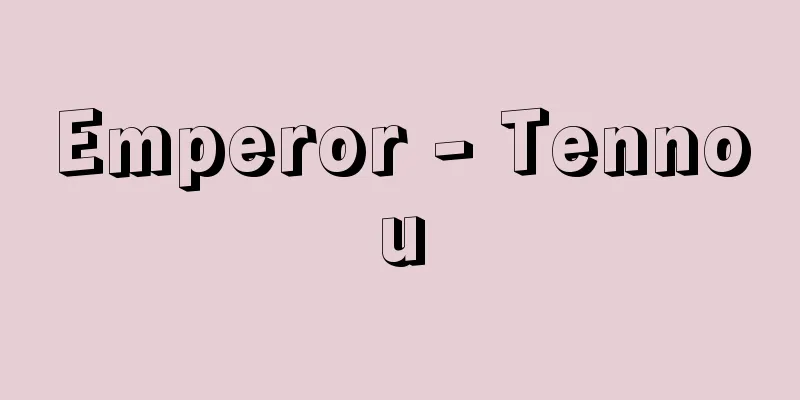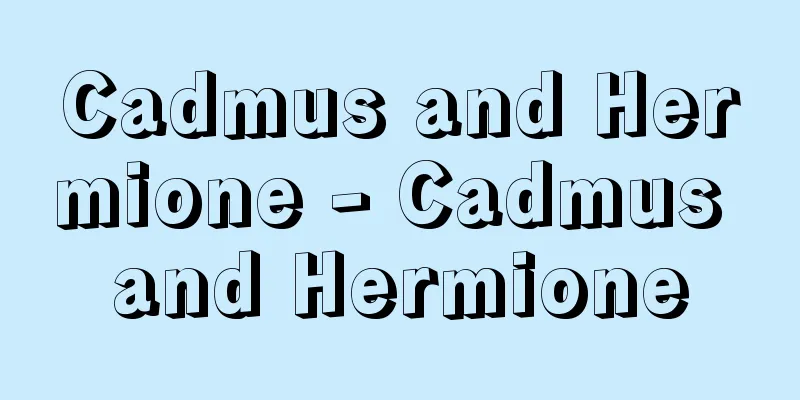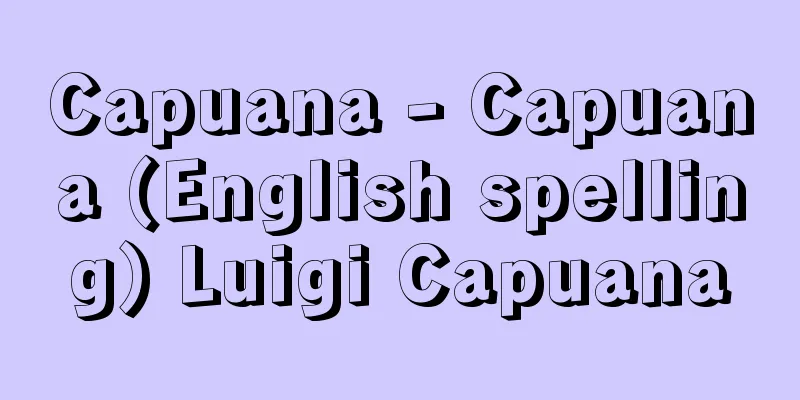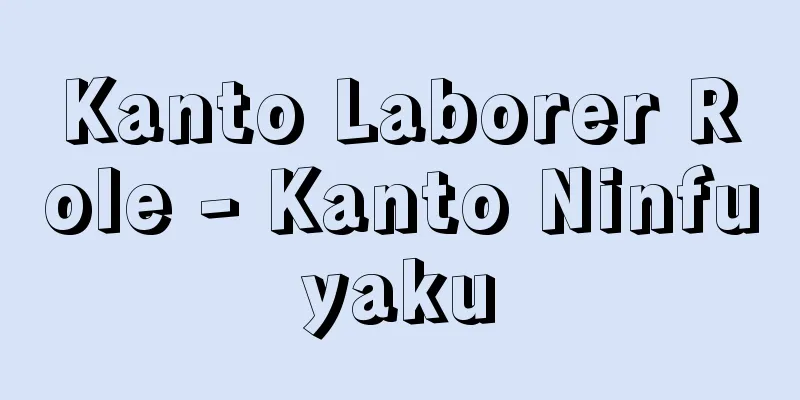Emperor - Tennou

|
The Emperor is the symbol of the state and the unity of the Japanese people, as defined in the Constitution of Japan (Chapter 1). It can refer to the position of the Emperor or to a specific individual who holds the position of Emperor. It began as a title used by the great kings of the Yamato court around the 7th century, and its powers have changed through ancient, medieval, early modern, and modern times, eventually reaching the modern symbolic Emperor system. [Shigeyoshi Murakami] Emperor's titleThe title Tenno was adopted from China and was pronounced as Sumera Mikoto, Suberagi, or Suberogi. In ancient China, mythical and legendary emperors were named Tenno, Jioh, and Jinoh, but generally, Tenno is the name of a Taoist deity, referring to the deified North Star. The only instance in China where an emperor was called Tenno was Gaozong of the Tang Dynasty (reigned 650-683), and in China it is an almost exclusively religious term. The first instance of the term being used in Japan is said to be in the Nihon Shoki, where Prince Shotoku sent a letter to Sui in 608 (the 16th year of the reign of Empress Suiko) in which he referred to himself as "Yamato no Tenno" (Eastern Emperor) in opposition to "Morokoshi no Kimi" (Western Emperor). The great kings of ancient nations adopted the title of Tenno in particular to emphasize that they were descendants of the gods of heaven, and to show that they were kings with a strong religious character, who performed rituals and festivals as the country's highest priests, thereby becoming one with the gods. The "sumera" in Sumera Mikoto, which is pronounced in Japanese, means "to rule," as in the act of threading a string through a jewel and holding both ends of it, and refers to governing. Mikoto is an honorific title for gods and people of high rank, and is thought to be an abbreviation of Mikotomochi, which means a person who takes on the words of the gods and speaks them. In other words, Sumera Mikoto means the honored one who governs. In relation to the gods, the emperor was referred to as Sumemima no Mikoto, meaning the grandson of the emperor. The honorifics and other names given to the Emperor have been extremely diverse throughout history. From around the middle of the 7th century, he was called Arahitogami (living god) or Akitsumikami (living god), as a sacred person who was one with the gods, and was also called "Hi no Miko" (child of the sun), meaning a descendant of Amaterasu Omikami. Other names for the Emperor since ancient times include Daikimi (great master), Ue (upper), Kami (upper), Shujo (master), Kojo (master), Seijo (master), Kinjo (present), Togin (present), Shison (supreme), Hijiri (sacred), Ichijin (one person), and many of them mean Kamigoichinin (master alone), meaning a sacred person currently residing at the top. The Chinese alternative name for the Emperor was also used as is. That is, the Emperor was called Tenshi (Son of Heaven), Tencho (Heavenly Court), or Iten no Kami (Lord of Heaven) because he received the mandate from heaven and ruled the world; Gyo (Gyo) because he controlled the four seas; Nanmen (Southern Court) because the Emperor faced south and his subjects faced north; Banjo (Wholesome Court), Tenman no Kami (Lord of the Ten Thousands), Iten no Kami (Lord of the Ten Thousands), etc., because the Emperor controlled a wide area in which he could dispatch 10,000 chariots. Furthermore, there were other names for the Emperor that came from Buddhism, such as Tenzen no Shi (Lord of the Ten Good Precepts) and Tenzen no Kami (King of the Ten Good Precepts) because he became king by the merit of keeping the Ten Good Precepts; Konrin (Golden Wheel), Kinrin Joou (Holy King), Seishu (Holy Lord), and Seiko (Holy Emperor) because they were kings who ruled the four continents of Sumeru. In addition, there are many other names for things related to the Emperor that indirectly refer to him. Mikado, referring to the gate of the Imperial Palace, Uchi, referring to the Dairi, and Ooyake, referring to the Imperial Court, were widely used. The Imperial Palace was also called Kinri, Kinri, and Kinchu because no one was allowed to enter without permission, and there were also names such as Shingi, referring to the Imperial Palace, and Joyo and Shaga, referring to the Emperor's vehicle. The honorific title Majesty, which refers to the lower floor of the Imperial Palace, originates from the fact that in China, the Son of Heaven is always accompanied by a group of soldiers called the Konoe, which are called the Imperial Guard. For external purposes, the title of Emperor was used in the sovereign letter of New Year in 1868 (Keio 4), just after the Meiji Restoration, but the title of Emperor was also used in conjunction. Later, in April 1936 (Showa 11), the external title was unified to Emperor. Emperors do not have surnames, and are given posthumous titles after their death. Posthumous titles that praise virtues during one's lifetime are also called shigou (posthumous names). The posthumous title system was established in an official decree under the Ritsuryo Code. Posthumous titles include the name of a residence or tomb, the posthumous title of a previous emperor with the character "ato" added, and a combination of one character from each of the posthumous titles of two previous emperors. After the Meiji era, the system of one emperor per era was adopted, and the era name became the posthumous title. [Shigeyoshi Murakami] Emperors in HistoryAncientIn the 6th and 7th centuries, the great kings of the Yamato court strengthened their power by subjugating local kings, known as Kimi and Wake, and formed an ancient unified state. In the 8th century, the Ritsuryo state was established, and the annual Niiname-sai, which was the source of the Emperor's authority and power as a priest-king, became the most important imperial ritual in which the Emperor became one with the gods. When a new Emperor ascended to the throne, a grand Niiname-sai ceremony was held once in a lifetime, called the Daijo-sai. The ancient imperial state reached its peak in the early Heian period, when the Emperor held political sovereignty and the right to administer national rituals, and his authority and power were based on the myths in the Kojiki and Nihon Shoki. The Emperor's religious authority was reinforced by Buddhism, Taoism, Onmyodo, and Confucianism, and the Imperial family became increasingly Buddhist, but the Imperial rituals that formed the basis of Shinto rituals actively incorporated Taoist rites and continued to resist assimilation with Buddhism. The Three Sacred Treasures of the Mirror, Sword, and Seal, which were symbols of the Imperial Throne, were passed down by successive Emperors and were given ideological and moral significance. The Emperor's governing power was weakened by the Fujiwara clan's regent system and the subsequent Insei system. [Shigeyoshi Murakami] middle agesAt the end of the 12th century, the Kamakura Shogunate was established, and the imperial court lost most of its real political power. After repeated defeats in conflicts with the Shogunate, the Emperor's right to rule gradually became mere name. However, the solemn observance of the Imperial Family's rituals was considered the most important matter for the Imperial Court, and funds were raised for the Daijosai ceremony by selling government officials and other means. In the mid-14th century, the Kenmu Restoration restored imperial rule, but it collapsed after only three years. For over half a century after this, the Northern and Southern Courts existed side by side, and conflict continued. The division of the imperial lineage reduced the authority of the Emperor, and in the 15th and 16th centuries after the unification of the Northern and Southern Courts, the Imperial Court was in extreme decline. The Niiname-sai ceremony, which was the core of the Imperial Family's rituals, was abolished for 220 years from the mid-15th century. There is no clear record of the Daijosai being held for 225 years from this time, and it was revived in the mid-Edo period along with the Niinamesai. The Ritsubō (the Prince's Establishment Ceremony) was abolished for 315 years from the late 14th century, and was revived in the mid-Edo period. [Shigeyoshi Murakami] Early modern periodThe Shokuho government, which unified the whole country from the late 16th century to the early 17th century, and the Edo Shogunate that followed it, supported the Emperor to justify and authoritatively control their political rule. Because the Ritsuryo system from ancient times continued to exist in name, the Shogunate increased the Imperial Court's land and court nobles' lands to the same extent as minor feudal lords, and revived rituals and ceremonies with the Shogunate's support, strengthening the Emperor's authority. However, the Shogunate did not allow the Emperor to have real political power, and kept the Imperial Court under strict control. The Emperor only held the nominal authority to create the calendar, change the era name, and bestow ranks and appoint officials. The Shogunate's pro-imperial and pro-shogunate stance eventually encouraged the development of pro-imperial sentiment, and in the late Edo period, pro-imperial and anti-shogunate sentiment based on Shinto, National Learning, Mitogaku, Confucianism, and other theories became popular. In the course of political struggles over opening up the country at the end of the Edo period, the shogunate requested an unusual imperial sanction for treaties from the Imperial Court, paving the way for the return of the emperor to politics. In the 1860s, a dual government was established in Edo and Kyoto, and anti-shogunate forces supported the emperor and overthrew the shogunate. [Shigeyoshi Murakami] ModernThe Meiji Restoration in 1868 (Keio 4, Meiji 1) brought about the restoration of the monarchy, and the unity of religion and politics was set as the basic political principle. The position of the Emperor in the modern imperial system was established by the Constitution of the Empire of Japan enacted in 1889 (Meiji 22) and the former Imperial House Law. The Emperor, as the head of state, holds political supreme power (right to govern) and military supreme power (supreme command) as the commander of the military, and also has traditional supreme power to perform rituals. Moreover, the Emperor himself was considered to be a sacred and inviolable living god. The concept of a living god was an adoption of the concept of god in monotheism, which was far removed from the ancient Japanese concept of gods, in which there was no break between humans and gods. The Emperor was considered to be a supreme being who embodied absolute truth and universal morality, and all values were unified in the Emperor. The authority and power of the Emperor was based on the Kojiki and Nihon shoki myths, and the integration of the Emperor with the gods of the Imperial Ancestors and the divine spirits of the successive Emperors was promoted. In the area of imperial rituals, new rituals were created, such as the Genshi-sai, the Kigen-setsu, and the Jinmu-tenno-sai, based on the myths of the Kojiki and Nihon shoki, and numerous other rituals for the spirits of the emperors' ancestors were also newly established. Shrines throughout the country were unified and reorganized with Ise Jingu, which enshrines the imperial ancestors, as the main sect, and became non-religious national public facilities performing national rituals. The emperor is, so to speak, the highest priest of State Shinto, and the rituals at shrines were based on the imperial rituals. [Shigeyoshi Murakami] present dayWith Japan's defeat in the war in 1945 (Showa 20), State Shinto was dissolved, and on New Year's Day the following year, in 1946, the Emperor issued a rescript known as the Humanity Declaration, denying his own divinity. The Constitution of Japan, which came into force in 1947, stipulated that the Emperor is the symbol of the State of Japan and the unity of the Japanese people. The Constitution stipulated the hereditary succession to the Imperial Throne and the acts of state to be performed by the Emperor, making the Emperor a ceremonial figure with no political authority. The Emperor's religious acts, including imperial rites, were deemed to be acts of the Imperial Court (private affairs) with no national or public character. At the same time as the Constitution, a new Imperial House Law was put into force, stipulating that the Imperial Throne should be passed on to male descendants and that the Emperor should reign for life. [Shigeyoshi Murakami] In 2017, a special law on the Imperial House Law regarding the abdication of the Emperor was enacted, and in 2019, the current Emperor abdicated in favor of the Crown Prince. [Editorial Department] The Emperor’s Food, Clothing and ShelterClothingDuring the Nara period, Chinese-style konben (festival robes) were used as formal attire. Konben is a red garment with a dragon pattern, and Konben is a crown. During the Heian period, the clothing of the Emperor was regulated for the first time, and for Shinto ceremonies, hakui (cloth) was used, and konben was used for formal attire, and for other occasions, a lacquered robe (sokutai) was worn. There was also a long-hemmed ohikinaoshi (cloth). Later, formal attire came to be used exclusively for enthronement ceremonies. During the Edo period, hakugofuku (cloth) was used for enthronement ceremonies, and saifuku (ceremonial attire) was used for Shinto ceremonies, and for everyday wear, a kinkoji (cloth) crown was worn, along with a white habutae kosode (short sleeved kimono) and scarlet kiribakama (scarf). From the mid-Edo period, the crown with a standing tassel was used. After the Meiji Restoration, Western clothing was worn except for sokutai and ko-naoshi for ceremonies and rites, and various military uniforms for the army and navy were established, as well as morning coats and suits. In modern times, sokutai is used for ceremonial wear, but suits are worn for everyday use, and tailcoats, morning coats, and tuxedos are worn for formal wear. [Shigeyoshi Murakami] DietSince the Heian period, the Emperor's meals were served on silver tableware on a tray, with rice, soup, fish and shellfish, seaweed, wooden confections, and Chinese sweets prepared. In the Edo period, there were offerings for everyday meals and offerings for annual events, and for everyday meals, blue and white tea bowls were placed on three sides of plain wood, with earthenware lids and chopsticks. Offerings for annual events include unique items such as New Year's Day miscellaneous dishes. Since the Meiji period, the Imperial Household Ministry's Daizen Ryo has prepared meals, and in modern times, the Daizen Division of the Imperial Household Agency's Management Department prepares the meals. [Shigeyoshi Murakami] LivingDuring the Heian period, the Emperor's residence was initially Jijuden in the Imperial Palace, but from the mid-Heian period onwards this was replaced by the Seiryoden, built in the Shinden-zukuri style. During the Edo period, the Tsuneyoden, built in the Shoin-zukuri style, became his residence. After the Meiji Restoration, the Emperor's residence was the Nishinomaru in the Imperial Palace in Tokyo, but after it was destroyed by fire, in 1889 (Meiji 22) the Meiji Palace was completed and the Tsuneyoden, built in the Shoin-zukuri style, became his residence. After Japan's defeat in the war, the Emperor's residence was the Western-style Gobunko, but in 1961 (Showa 36) a new palace was completed and he became the Emperor's residence in the Fukiage Palace. [Shigeyoshi Murakami] "The Emperor" edited by Kodama Kota (1978, Kondo Publishing)" ▽ "The Emperor's Rituals" by Murakami Shigeyoshi (1977, Iwanami Shoten) ▽ "The Imperial Family Dictionary" by Ihara Yoriaki (1938, Tomiyama Publishing) [References] | | | | | | Imperial | |©Shogakukan Library "> Emperor Meiji ©Shogakukan Library "> Emperor Taisho Source: Shogakukan Encyclopedia Nipponica About Encyclopedia Nipponica Information | Legend |
|
日本国憲法(第1章)に定められた日本国および日本国民統合の象徴。天皇の地位をさす場合と、天皇の地位にある特定の個人をさす場合とがある。7世紀ごろ大和(やまと)朝廷の大王(おおきみ)が用いた称号に始まり、その権能は古代、中世、近世、近代と変遷を経て、現代の象徴天皇制に及んでいる。 [村上重良] 天皇の称号天皇という称号は、中国から取り入れたもので、スメラミコト、スベラギ、スベロギなどと訓(よ)んだ。古代中国では、神話伝説上の帝王に、天皇氏、地皇氏、人皇氏があるが、一般には、天皇とは道教系の神名で、北極星を神格化した神をいう。中国で皇帝が天皇と称した例は、唐の高宗(在位650~683)があるのみで、中国ではもっぱら宗教上の用語である。日本での用例は、608年(推古天皇16)聖徳太子が隋(ずい)に送った国書に、「西皇帝(もろこしのきみ)」に対して「東天皇(やまとのてんのう)」と称したとの『日本書紀』の記述が最初とされる。古代国家の大王がとくに天皇の称号を採用したのは、自己が天の神の子孫であることを強調するとともに、国の最高祭司として自ら祭祀(さいし)を行い、祭りをすることによって神と一体化するという宗教的性格の強い王であることを表したものであろう。日本訓みのスメラミコトのスメラは、玉に紐(ひも)を通してその両端を握る意味の「統(す)べる」で、統治することをいう。ミコトは、神や身分の高い人の敬称で、神のことばを身に受け、神のことばを発する人を意味するミコトモチの略とされる。すなわち、スメラミコトとは、統治する尊い方という意味である。天皇は、神祇(じんぎ)に対しては、皇孫の意味でスメミマノミコトと称した。 天皇の敬称、別称は、歴史上きわめて多彩である。7世紀中ごろからは、神と一体の尊い人として現人神(あらひとがみ)、現御神(あきつみかみ)とよばれ、また天照大神(あまてらすおおみかみ)の子孫の意味で「日の御子(みこ)」ともよばれた。古代以来の天皇の別称には、大君、上(うえ)、上(かみ)、主上、皇上、聖上、今上(きんじょう)、当代、当今(とうぎん)、至尊、聖(ひじり)、一人(いちじん)などがあり、上御一人(かみごいちにん)、すなわち現に上に在る尊い人という意味のことばが多い。また中国での皇帝の別称もそのまま用いられた。すなわち、天命を受けて天下を統治することから天子、天朝、一天の君、四海を統御する意味で御(ぎょ)、天子は南面し臣下は北面することから南面、天子は一万の兵車を出す広い土地を治めることから万乗(ばんじょう)、万乗の君、一天万乗の君などの称がある。さらに、仏教から出た天皇の別称があり、十善戒を守る功徳(くどく)で王となるとされることから十善の主、十善の王とよび、須弥四洲(しゅみししゅう)を治める王の意味で金輪(こんりん)、金輪聖王(じょうおう)、聖主、聖皇と称した。 そのほか、天皇に関連のある事物で、間接的に天皇をさす別称も多い。皇居の門をいうミカド、内裏(だいり)をさすウチ、朝廷をさすオオヤケなどは広く用いられた。また、皇居は、みだりに立ち入りを許されないことから、禁裏、禁裡(きんり)、禁中とよび、皇居をさす宸儀(しんぎ)、天皇の乗り物をさす乗輿(じょうよ)、車駕(しゃが)などの称もある。天皇に付す敬称の陛下は、皇居の階下のことで、中国で、天子にはつねに近衛(このえ)の兵士が階下に連なっていることに由来する。対外的には、明治維新直後の1868年(慶応4)正月の国書で天皇の称号を用いることとしたが、皇帝の称号も併用された。のち1936年(昭和11)4月、対外的称号は天皇に統一された。 なお、天皇には姓はなく、死後に追号が贈られる。生前の徳をたたえる追号は、諡号(しごう)ともいう。追号の制度は、律令(りつりょう)の公式令(くしきりょう)で確立した。追号には、在所、山陵の名、先の天皇の追号に「後」を付したもの、先の2人の天皇の追号から1字ずつを採り合わせたものなどがある。明治以後は一世一元制となり、元号が追号とされている。 [村上重良] 歴史上の天皇古代6~7世紀に、大和朝廷の大王は、キミ、ワケとよばれる各地の王を服属させて権力を強大にし、古代統一国家を形成した。8世紀には律令国家が確立し、祭司王としての天皇の権威と権力の根源をなす年ごとの新嘗祭(にいなめさい)は、天皇が神と一体となるもっとも重要な皇室祭祀となった。新たに天皇が即位すると、一代一度の新嘗祭の大祭を行い、大嘗祭(だいじょうさい)と称した。古代天皇制国家は平安前期に最盛期を迎え、天皇は政治上の統治権と、国の祭祀をつかさどる祭祀権を保持し、その権威と権力は『古事記』『日本書紀』の神話によって根拠づけられた。天皇の宗教的権威は仏教、道教・陰陽道(おんみょうどう)、儒教によって補強され、皇室の仏教化が進行したが、神祇祭祀の原基をなす皇室祭祀は、道教の儀礼を積極的に取り入れて、仏教との習合を拒み続けた。皇位のしるしとされる鏡、剣、璽(たま)の三種の神器は、歴代の天皇によって受け継がれ、思想的、道徳的に意義づけられた。天皇の統治権は、藤原氏の摂関政治と、これに続く院政によって力を弱めた。 [村上重良] 中世12世紀末、鎌倉幕府が成立し、王朝勢力は政治の実権の大半を失った。たび重なる幕府との抗争に敗れて、天皇の統治権はしだいに有名無実となった。しかし、皇室祭祀の厳修は朝廷の最重要事とされ、大嘗祭の挙行にあたっては、売官等による資金の調達が行われた。14世紀なかばには、建武(けんむ)中興によって天皇の親政が復活したが、わずか3年で崩壊した。こののち半世紀余にわたり、南北朝が併立して抗争が続いた。皇統の分立で天皇の権威は低下し、南北朝合一後の15~16世紀には、朝廷は極度に衰微した。皇室祭祀の中心をなす新嘗祭は、15世紀なかばから220年にわたって廃絶した。大嘗祭も、この時期から225年間、明確な挙行の記録がなく、新嘗祭とともに江戸中期に再興された。立坊(りつぼう)(立太子礼(りったいしれい))は、14世紀後半から315年にわたって廃絶し、江戸中期に再興された。 [村上重良] 近世16世紀後半から17世紀初頭に全国を統一した織豊(しょくほう)政権と、それに続く江戸幕府は、天皇を擁して、自らの政治支配を正当化し権威づけた。古代以来の律令制は形のうえでは生き続けていたから、幕府は朝廷に小大名なみの御料(領地)と公家(くげ)領を増進し、幕府の援助で祭祀、行事を再興して、天皇の権威を強化した。しかし、幕府は天皇が政治上の実権をもつことは許さず、朝廷を厳しい統制下に置いた。天皇は、名目的な作暦、改元、叙位任官の権限を保持していたにすぎなかった。幕府の尊王擁幕の姿勢は、やがて尊王論の発達を促す結果となり、江戸後期には、神道(しんとう)、国学、水戸学、儒教などにたつ擁幕あるいは反幕の尊王論が盛んになった。幕末、開国をめぐる政争の過程で、幕府は朝廷に異例の条約勅許を請い、天皇の政治的復活に道を開いた。1860年代には江戸と京都の二重政権が成立し、倒幕勢力は天皇を擁して幕府を打倒した。 [村上重良] 近代1868年(慶応4・明治1)の明治維新によって、王政復古が実現し、祭政一致が政治理念の基本として掲げられた。近代天皇制における天皇の地位は、1889年(明治22)制定の大日本帝国憲法と旧「皇室典範」によって確立した。天皇は、国の元首として政治大権(統治権)、軍の統率者として軍事大権(統帥権(とうすいけん))を一身に保持するとともに、伝統的な祭祀大権を有し、しかも、天皇自身は神聖不可侵な現人神(あらひとがみ)とされた。現人神の観念は、人と神の間に断絶のない日本古来の神観念からかけ離れた一神教の神観念を取り入れたもので、天皇は絶対的真理と普遍的道徳を体現する至高の存在とされ、あらゆる価値は天皇に一元化された。天皇の権威と権力は記紀神話によって根拠づけられ、皇祖の神々および歴代天皇の神霊と天皇との一体化が進められた。皇室祭祀では、記紀神話に基づく元始祭、紀元節祭、神武(じんむ)天皇祭が新たにつくられ、また天皇の祖先である皇霊のための祭祀がおびただしく新定された。全国の神社は、皇祖神を祀(まつ)る伊勢(いせ)神宮を本宗(ほんそう)として一元的に再編成され、国家の祭祀を行う非宗教の国家的公的施設となった。天皇は国家神道のいわば最高祭司であり、神社の祭式は皇室祭祀を基準に整えられた。 [村上重良] 現代1945年(昭和20)敗戦によって国家神道は解体し、翌1946年元日、天皇はいわゆる人間宣言の詔書で、自らの神格を否定した。1947年施行の日本国憲法は、天皇を日本国および日本国民統合の象徴と規定した。憲法は、皇位の世襲と、天皇が行う国事行為などを定め、天皇は政治上の権限をもたない儀礼的な存在となった。皇室祭祀をはじめ天皇の宗教的行為は、国家的・公的性格をもたない内廷行為(私事)とされた。憲法と同時に、新しい皇室典範が施行され、皇位の男系男子による継承、天皇の終身在位などが規定された。 [村上重良] 2017年、天皇の退位等に関する皇室典範特例法が成立し、2019年に今上天皇から皇太子への譲位が行われた。 [編集部] 天皇の衣食住衣生活奈良時代には、礼服として唐風の袞冕(こんべん)が用いられた。袞は赤色の袞竜の文様のある衣で、冕は冠である。平安時代には、初めて天皇の衣服が規定され、神事の祭服には帛衣(はくい)、礼服には袞冕を用い、それ以外には束帯の黄櫨染(こうろぜん)の袍(ほう)を着用した。また略装として裾(すそ)の長い御引直衣(おひきなおし)があった。のち礼服は、もっぱら即位礼に用いられるようになった。江戸時代には、即位礼に帛御服(はくのごふく)、神事に斎服を用い、日常は、御金巾子(おきんこじ)の冠に、白羽二重小袖(はぶたえこそで)、緋(ひ)の切袴(きりばかま)を着用した。江戸中期からは、冠は纓(えい)が直立した立纓(りゅうえい)の冠が用いられた。明治維新後は、祭祀、儀式に束帯、小直衣などを用いるほかは、洋服となり、陸軍式、海軍式の各種軍装が定められ、またモーニング、背広なども用いられた。現代では、儀服に束帯などが用いられるほかは、日常は背広、礼服には燕尾(えんび)服、モーニング、タキシードなどが着用される。 [村上重良] 食生活平安時代以来、天皇の食事は、台盤に銀の食器をのせ、御飯、羹(あつもの)、魚貝、海草、木菓子、唐菓子などを調進した。江戸時代には、日常の供御(くご)と年中行事の供御があり、日常の食饌(しょくせん)では、白木の三方に染付の茶碗(ちゃわん)をのせ、土器の蓋(ふた)、楊箸(やなぎばし)を用いた。年中行事の供御には、元日の烹雑(ほうぞう)など独特のものがある。明治以後は宮内省大膳(だいぜん)寮、現代では宮内庁管理部大膳課が食饌を調進する。 [村上重良] 住生活平安時代には、初め内裏の仁寿殿(じじゅうでん)が天皇の住居であったが、平安中期以降、寝殿造の清涼殿にかわった。江戸時代には、書院造の常御殿が住居となった。明治維新後は、東京の皇居内の西の丸が住居であったが、火災で焼失後、1889年(明治22)明治宮殿が成って、書院造の常御殿が住居となった。敗戦後は、洋風の御文庫が住居となったが、1961年(昭和36)新宮殿が完成し、吹上(ふきあげ)御所が住居となった。 [村上重良] 『児玉幸多編『天皇』(1978・近藤出版社)』▽『村上重良著『天皇の祭祀』(1977・岩波書店)』▽『井原頼明著『皇室事典』(1938・冨山房)』 [参照項目] | | | | | | | |©小学館ライブラリー"> 明治天皇 ©小学館ライブラリー"> 大正天皇 出典 小学館 日本大百科全書(ニッポニカ)日本大百科全書(ニッポニカ)について 情報 | 凡例 |
Recommend
Ceramics - Ceramics
〘Noun〙 Ceramics produced mainly in Seto City, Aich...
Obrodenie
…a cultural movement widespread among the peoples...
Osmanl - Osmanl
...Using their political positions and close ties...
Efemerides Astronomicas (English spelling)
...Used for various astronomical observations, as...
Ishan Albahuriyat - Ishan Albahuriyat
…the capital of the Isin 1st Dynasty (2017-1794 B...
Day of the Dog
This is the day that corresponds to the Dog in th...
Sanshu [village] - Samizu
A village in Kamiminochi County in northern Nagano...
Emperor Kinmei
Year of death: 32nd year of Emperor Kinmei (571) Y...
Al-Wāqidī, Abū `Abd Allāh Muḥammad ibn `Umar
[Raw] 747. Black porgy Died April 28, 823. Arab hi...
Omo
The leading role in a kyogen play. Today, he is of...
Tithonos (English spelling)
A character from Greek mythology. He was one of th...
Goolagong, E. (English spelling) GoolagongE
...refers to the indigenous people who lived on t...
Grosseteste, Robert
Born: February 3, 1168 in Suffolk [Died] October 9...
Active element
A circuit element that acts as an energy source fo...
Turkmen - Turkmen (English spelling)
It is one of the Turkic languages. It is spoken b...








![Aga Khan [I] - Aga Khan](/upload/images/67cf1f93ed2a9.webp)
